polysystem theory 多元系统理论 ppt课件
- 格式:ppt
- 大小:1.23 MB
- 文档页数:11
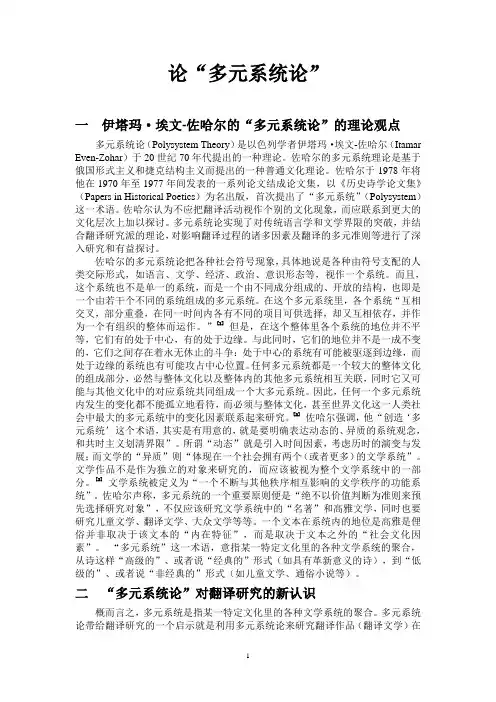
论“多元系统论”一伊塔玛·埃文-佐哈尔的“多元系统论”的理论观点多元系统论(Polysystem Theory)是以色列学者伊塔玛·埃文-佐哈尔(Itamar Even-Zohar)于20世纪70年代提出的一种理论。
佐哈尔的多元系统理论是基于俄国形式主义和捷克结构主义而提出的一种普通文化理论。
佐哈尔于1978年将他在1970年至1977年间发表的一系列论文结成论文集,以《历史诗学论文集》(Papers in Historical Poetics)为名出版,首次提出了“多元系统”(Polysystem)这一术语。
佐哈尔认为不应把翻译活动视作个别的文化现象,而应联系到更大的文化层次上加以探讨。
多元系统论实现了对传统语言学和文学界限的突破,并结合翻译研究派的理论,对影响翻译过程的诸多因素及翻译的多元准则等进行了深入研究和有益探讨。
佐哈尔的多元系统论把各种社会符号现象,具体地说是各种由符号支配的人类交际形式,如语言、文学、经济、政治、意识形态等,视作一个系统。
而且,这个系统也不是单一的系统,而是一个由不同成分组成的、开放的结构,也即是一个由若干个不同的系统组成的多元系统。
在这个多元系统里,各个系统“互相交叉,部分重叠,在同一时间内各有不同的项目可供选择,却又互相依存,并作为一个有组织的整体而运作。
”[1]但是,在这个整体里各个系统的地位并不平等,它们有的处于中心,有的处于边缘。
与此同时,它们的地位并不是一成不变的,它们之间存在着永无休止的斗争:处于中心的系统有可能被驱逐到边缘,而处于边缘的系统也有可能攻占中心位置。
任何多元系统都是一个较大的整体文化的组成部分,必然与整体文化以及整体内的其他多元系统相互关联,同时它又可能与其他文化中的对应系统共同组成一个大多元系统。
因此,任何一个多元系统内发生的变化都不能孤立地看待,而必须与整体文化,甚至世界文化这一人类社会中最大的多元系统中的变化因素联系起来研究。
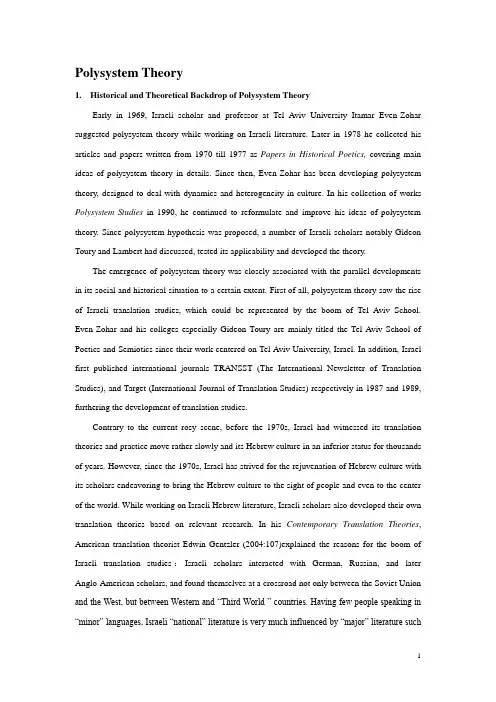
Polysystem Theory1. Historical and Theoretical Backdrop of Polysystem TheoryEarly in 1969, Israeli scholar and professor at Tel Aviv University Itamar Even-Zohar suggested polysystem theory while working on Israeli literature. Later in 1978 he collected his articles and papers written from 1970 till 1977 as Papers in Historical Poetics, covering main ideas of polysystem theory in details. Since then, Even-Zohar has been developing polysystem theory, designed to deal with dynamics and heterogeneity in culture. In his collection of works Polysystem Studies in 1990, he continued to reformulate and improve his ideas of polysystem theory. Since polysystem hypothesis was proposed, a number of Israeli scholars notably Gideon Toury and Lambert had discussed, tested its applicability and developed the theory.The emergence of polysystem theory was closely associated with the parallel developments in its social and historical situation to a certain extent. First of all, polysystem theory saw the rise of Israeli translation studies, which could be represented by the boom of Tel Aviv School. Even-Zohar and his colleges especially Gideon Toury are mainly titled the Tel Aviv School of Poetics and Semiotics since their work centered on Tel Aviv University, Israel. In addition, Israel first published international journals TRANSST (The International Newsletter of Translation Studies), and Target (International Journal of Translation Studies) respectively in 1987 and 1989, furthering the development of translation studies.Contrary to the current rosy scene, before the 1970s, Israel had witnessed its translation theories and practice move rather slowly and its Hebrew culture in an inferior status for thousands of years. However, since the 1970s, Israel has strived for the rejuvenation of Hebrew culture with its scholars endeavoring to bring the Hebrew culture to the sight of people and even to the center of the world. While working on Israeli Hebrew literature, Israeli scholars also developed their own translation theories based on relevant research. In his Contemporary Translation Theories, American translation theorist Edwin Gentzler (2004:107)explained the reasons for the boom of Israeli translation studies:Israeli scholars interacted with German, Russian, and later Anglo-American scholars, and found themselves at a crossroad not only between the Soviet Union and the West, but between Western and “Third World ” countries. Having few people speaking in “minor” languages, Israeli “national” literature is very much influenced by “major” literature suchas German, Russian and Anglo-American literatures. Worse still, Israel, lacking a canon of literary works, was totally dependent upon foreign language texts to provide both diversity and depth. Hence, the survival of the nation became dependent on translation.Thanks to the importance of translation, translation studies has thereupon gradually come to prominence in Israeli academic circle. There is no doubt that the development of polysystem theory constitutes an integral part of the rise of Israeli translation studies.Polysystem theory has its origins in comparative literature and the structuralist and semiotic traditions of the Russian Formalists and Czech Structuralists. The general approaches adopted by Even-Zohar and Gideon Toury rely to a great extent on the Russian Formalists in the 1920s---Viktor Shklovskij, Jurij Tynjanov, Roman Jakobson and others, and their successors in the following decade, mainly the Czech Structuralists, among which the ideas of Jurij Tynjanov played a vital role in the formulation of “polysystem”. Having introduced the concept of “system”, Tynjanov viewed a literary work as part of a literary system, which itself is defined as “a system of functions of the literary order which are in continual inte rrelationship with other orders”(Munday 2001:109). Based on this concept, Even-Zohar developed a new term “polysystem”. Apart from this, Even-Zohar and Gideon Toury borrowed from multiple other ideas of Tynjanov, such as his hierarchical structure of differing literary systems, his concept of defamiliarization as the measuring device for historical literary significance, and even his concept of literary mutation and evolution.Using the work of Tynjanov and other Formalists as his starting point, Even-Zohar took up the systematic approach, aiming initially to resolve certain problems connected with translation theory and the historical structure of Hebrew literature. His application of the Formalists’ ideas in these areas finally resulted in the formulation of polysystem theory.In conclusion, the favorable socio-historical background of polysystem theory has facilitated its emergence while the ideas of Formalists and Structuralists have laid a solid theoretical foundation for it.1.2 Development of Polysystem Theory in the WestEver since it was formulated, polysystem theory has experienced many a drastic change. A number of scholars in various countries have attempted to improve, advance, enlarge and experiment with the theory, promoting its development.2 Major Concepts of Polysystem TheoryPolysystem theory is actually not intended for translation studies; instead, it is a theory on culture. Even-Zohar’s essay “Polysystem Theory”, as the core of polysystem theory, boasts three versions. “Polysystem Theory” was first published in 1979 and the second in 1990, both pertaining to the literary study and the translation studies. Subsequently, the 1997 version indicates that polysystem theory has already evolved from a literary theory to an ordinary cultural theory3.2.1 Even-Zohar’ s PolysystemThe concept of polysystem coined by Even-Zohar constitutes a fundamental idea of polysystem theory. During his research, he adopted one of the currently leading ideas that sign-governed human patterns of communication, also known as semiotic phenomena, including culture, language, literature, and society should be regarded as systems rather than conglomerates of disparate elements. Based on this idea, Zohar (1990:11) defined “p olysystem” as follows: Polysystem is “…a semiotic system…a heterogeneous, open structure. It is, therefore, very rarely a uni-system but is, necessarily, a polysystem-a multiple system,a system of various systems which intersect with each other and partly overlap, usingconcurrently different options, yet functioning as one structured whole, whosemembers are interdependent.”Any polysystem, as Even-Zohar(1990:23) argued, is actually part of a larger polysystem, which in turn constitutes part of a “maga-polysystem”, i.e. the “total culture” of the said community organizing and controlling several communities. The borders separating adjacent systems shift all the time, not only within systems, but between them. However, with a polysystem one must not think in terms of one center and one periphery, since several such positions are hypothesized. Thus, instead of analyzing single texts and classifying them, he explored multiple texts and the complex intra- and inter-relations they enter into as they form a highly stratified but unified whole.The intra-relations of the polysystem tend to be complicated and changeable. The various strata and subdivisions which comprise a given polysystem are not equal, but hierarchized within the polysystem. They are constantly competing with each other for the dominant position. In particular, in the case of the literary polysystem there is a continuous state of tension between thecentre and the periphery, in which different literary genres all vie for domination of the center.What highlights the polysystem theory should be the heterogeneity of culture, which, for instance, is manifested in a situation where a community possesses two or more literary systems, two “literature” within the realm of literature. A s Even-Zohar(1990:13) claimed, the polysystem hypothesis is designed precisely to deal with such heterogeneity, aiming to investigate the particular conditions under which a certain literature may be interfered with by another literature, as a result of which properties are transferred from one polysystem to another.Based on Shklovskij’s idea regarding “canonized” and “non-canonized”, Even-Zohar(1990:15) developed those two genres, which are defined explicitly as follows:B y “canonized” one means those literary norms and works (i.e., both models andtexts) which are accepted as legitimate by the dominant circles within a culture andwhose conspicuous products are preserved by the community to become part of itshistorical heritage. “Non-canonized” means those norms and texts which are rejectedby these circles as illegitimate and whose products are often forgotten in the long runby the community (unless they change their status).The tensions between “high” or “canonized” genres (e.g. poetry) and “low” or “non-canonized” genres (e.g. popular literature, popular art, translated works, “sub-culture” in whatever sense, etc.) are universally present in every human culture. The “low” genres on the periphery constantly compete for the central position, which eventually results in literary evolution. When there is no “sub-culture” to exert real pressures on canonized culture, a vital canonized culture is very unlikely to exist. In other words, any canonized activity is bound to gradually become petrified without the stimulation of a strong “sub-culture”.The center of the whole polysystem is identical with the most prestigious canonized repertoire. Repertoire is conceived of here as the aggregate of laws and elements (single, bound or total models) that govern the production of texts (Even-Zohar 1990: 17). In the repertoire there exists the primary vs. secondary opposition, that is, innovativeness vs. conservatism. In a conservative established repertoire (and system), each individual product will be highly predictable. Products of such state are labeled as “secondary”. Within an innovative repertoire (and system) which reduces the possibility of each product being predictable by the introduction of new elements, it offers models of the “primary” type. The struggle between the primary andsecondary options is decisive for the system’s evolution. When a primary form maintains a central position in the literary polysystem, it brings about innovatory forces. But once it achieves the canonized status for some time, it tends to remain conservative, and becomes the secondary form because there are newer models that are pushing it to the peripheral position. However, stability or instability of repertoire do not reflect, or necessarily generate, stability or instability of the system. From the functional point of view, a system incapable of maintaining itself over a period of time is often on the verge of collapse.As for the principle of polysystem theory, Even-Zohar (1990:13) stressed that the polysystem hypothesis involves a rejection of value judgments as criteria for an a priori selection of the objects of study. Meanwhile, he explained that excluding the selection of objects to be studied according to taste does not mean that either particular “values” or evaluation in general are excluded by any section of the sciences of man as active factors to be accounted for.To sum up, polysystem is heterogeneous and dynamic, which gives explanation to how the polysystem processes. Polysystem theory has been a challenge to the homogeneity tradition. By including all of these excluded parameters such as variety, conflict contradiction, change and the time flow, it thereby makes the idea of system fully compatible with heterogeneity and the flow of time.2. 2 The Position of Translated LiteratureAs noted above, polysystem theory holds that translated literature previously unnoticed should be connected with original literature. Even-Zohar viewed literature as a polysystem, a system of systems, which can be described by a series of oppositions: between the center and the periphery, between the canonized system (which usually occupies the center of the polysystem) and the non-canonized system, between translated and non-translated literature. The literary system is defined as the network of relations that is hypothesized to obtain between a number of activities called “literary”, and consequently these activities themselves observed via that network (Even-Zohar 1990:28).Even-Zohar proposed that translated works correlate and translated literature may possess a repertoire of its own. He conceived of translated literature not only as an integral system within any literary system but also as a most active system within it. Having established its systemtic status, Even-Zohar then proceeded to discuss its role and significance within the literary system inhis essay “The position of Translated Literature within the Literary Polysystem”. The essay boasted two versions: the first one was presented by Even-Zohar to the Dutch/Belgian group at the historic 1976 Translation Studies Colloquium in Leuven, Belgium; in 1990 Even-Zohar incorporated its revised version in his collection Polysystem Studies.In the essay mentioned above, Even-Zohar(1990:48) elaborated the position of translated literature within a literary system. When it assumes a central position, it participates actively in shaping the center of the polysystem. When it maintains a peripheral position, it constitutes a peripheral system within the polysystem, generally employing secondary models.Even-Zohar (1978) suggested that the relationship between translated works and the literary polysystem cannot be identified as either primary or secondary, but as a variable, depending upon the specific circumstance operating within the literary system. Generally speaking, the “normal” position of translated literature tends to be in a peripheral one, yet there exist some exceptions. He (Even-Zohar 1990:47) identified the following three major conditions contributing to the translated literature as a central system in the literary polysystem:i.when a polysystem has not yet been crystallized, that is to say, when a literature is“young”, in the process of being established;ii.ii.when a literature is either “peripheral”(within a large group of correlated literature) or “weak” or both;iii.when there are turning points, crises, or literary vacuums in a literature.He also described the interaction between translation literature and target literature polysystem, and summarized the principle for each situation. The first case was in Israel, and the second in Low Countries and the last could be found in America in the 1960s.The position taken by translated literature is decisive to translation norms, behaviors, and policies. When it assumes a central position in the literary polysystem and functions as a vehicle for creating new, primary models, the translator is far more likely to strive for such translation which is closer to the original in terms of adequacy. On the contrary, if translation occupies a secondary position within a given polysystem, the chances that the translator will attempt to find ready-made models for translation for the sake of the demand of translation norm “acceptability”are much greater than otherwise.The analysis of translated literature proves more than marginal, though it is one aspect ofZohar’s investigation.As a matter of fact, it has far-reaching consequences for the field of translation studies.2. 3 Toury’s Translation NormsNorms, a central concept in the study of translation by the Tel Aviv School, originated from the idea of the Prague structuralist Jiri Levy, who first applied the concept of norms to translation studies. In his doctoral dissertation (1971)4, Itamar Even-Zohar used this concept, based on which Gideon Toury introduced and developed the notion of Translation Norms. In his book Descriptive Translation Studies and Beyond, Toury(1995:55) outlined his definition of translation norms as follows:The translation of general values or ideas shared by a community-as to what is right or wrong, adequate or inadequate-into performance instructions appropriate forand applicable to particular situations.A given society always has multiple and conflicting norms, all interconnected with other functioning subsystems, but if situations recur regularly, certain behavioral pattern can be established. The same holds true for translation norms. Thus, Toury (1995:56-61) continued to identify three kinds of translation norms operating at different stages of the translation processes, i.e. initial norms, preliminary norms, and operational norms.The basic “initial norms” refers to a general choice made by translators to subject themselves either to original text with its textual relations and norms, or the target culture’s linguistic and literary norms, or some combination thereof.Under initial norms lie “preliminary norms” and “operational norms”. Preliminary norms involve the existence and nature of a translation policy and the directness of translation, i.e. a particular society’s tolerance or intolerance towards a translation ba sed on a text in an intermediate language rather than on the source language text.Operational norms concern decisions made during, rather than prior to, the actual act of translation. It is composed of matricial norms and text-linguistic norms. The former concern the completeness of the target text, and have to do with the way textual material is distributed, how much of the text is translated, and any changes in segmentation. Phenomena include omission or relocation of passages, textual segmentation and the addition of passages or footnotes. The latter relate to the selection of target text linguistic material including lexical items, phrases and stylisticfeatures.Given the fact that translation is a norm-governed activity, to distinguish regular tendencies, it is necessary to study not only single texts, but also different translations of the same original text and even extratextual sources. Consequently, Toury proposed two major sources investigating translational norms: textual sources, namely the target texts themselves; and extratextual sources, i.e. the theoretical and critical statements made about translation in general or about specific translation in general or about specific translations.It is believed that translation norms are to a great extent influenced by the position assumed by translated literature within the polysystem. Norms determine the position of translations on an imaginary axis between two extreme possibilities: adequacy and acceptability. Adequacy means a functional equivalence between the source text and target text achieved by reconstructing the original functions of the elements comprising the source text while acceptability demands that the target text should be adjusted to the system receiving it.Although Toury’s concept of norms focuses mainly on their function as a descriptive category to identify translation patterns, such supposedly non-prescriptive norms have triggered both approval and disapproval within society. Later some translation theorists such as Theo Hermans and Andrew Chesterman further developed translation norms. For instance, Chesterman proposed another set of norms—product or expectancy norms and process or professional norms, covering the area of Toury’s initial and operational norms.3. Extension of Polysystem TheoryEver since 1969 when it was first suggested, polysystem theory has been developed, revised and perfected by a large number of scholars, engendering other systems theories.Perhaps the most significant extension of the polysystem model should be found in Toury’s work. Having adopted the polysystem theory framework, Gideon Toury consolidated Even-Zohar’s target-oriented approach and conducted his descriptive research, aiming to better detect and describe all those linguistic, literary and sociological laws which govern translation. After his early polysystem work on the sociocultural conditions determining the translation of foreign literature, Toury shifted his focus from theory to descriptive work since 1980 and strived to develop a general theory of translation. To replace the commonplace isolated free-standing studies, he used the abbreviation DTS, introduced by Holmes, to refer to the scientific branch andthe longer denomination “descriptive translation studies”, to the activity—any research procedures addressed to translational phenomena. The ultimate aim of DTS is to identify the patterns of behavior in translation and then to “reconstruct” the norms at work in the translation process.In his Descriptive Translation Studies-And Beyond, Toury (1995: 36-39 and 102), encompassed a description of the product and the wider role of the sociocultural system and elaborated three-phase methodology for systematic DTS as follows:1) Situate the text within the target culture system, looking at its significance or acceptability;2) Compare the source text (ST) and target text (TT) for shifts, identifying relationships between “coupled pairs” of source text (ST) and target text (TT) segments, and attempting generalization about the underlying concept of translation;3) Draw implications for decision-making in future translating.Jose Lambert, one of polysystem theory’s strongest advocates during the 1980s, retained a systemic approach while suggesting that the system as conceived may not function as the investigating scholar initially thought. As a result, he was open to the study of “other” patterned behavior which may help explain translated phenomena. Together with Van Gorp, he called for not only a study of the relation between authors, texts, readers, and norms in the two differing systems, but also for relations between authors’ and the translators’ intentions, between pragmatics and reception in source and target systems, between the differing literary systems, and even between differing sociological aspects including publishing and distribution (Gentzler 2004:132).With its considerable influence, polysystem theory has inspired another important school: the Manipulation School, which has grown up in Leuven, Belgium, where several meetings and conferences around the theme of translated literature were held by the International Comparative Literature Association. The group of scholars carried on the polysystem theorists’ point of view, and got the name because of their conviction that from the target perspective all translation implies a degree of manipulation of the source text for a certain purpose.Polysystem theory has also made its mark in the work of Andrew Lefevere. Though he distanced himself from polysystem vocabulary, his work in translation studies actually developed out of his strong links with polysystem theory and the Manipulation School. Moving away from polysystem terminology, he proposed the addition of notions of polarity, periodicity and patronage and considered the role of ideology and patronage in the system of translated literature.Furthermore, his later work on translation and culture in many ways represents a bridging point to the cultural turn.In conclusion, polysystem theory has inspired a variety of scholars to study translation in another way and to supplement its model. In other words, polysystem theory has found itself developed in DTS and the ideas of Manipulation School as well as Lefevere’ work.4. Influence of Polysystem Theory on Translation StudiesThe work of Even-Zohar, polysystem theory’s initiator, is highly innovative, presenting multiple significant insights for the field of translation theory. Above all, his polysystem theory proves to be revolutionary because it moves the study of translation out of the static, source-oriented linguistic paradigm and obsession with one-to-one equivalence and forward into a less prescriptive observation of translation within its different contexts.Polysystem theory advocates a descriptive, systematic, target-oriented approach to translation studies, inspiring a multinational translation studies school. Moreover, its definition of “equivalence” and “adequacy” according to the historical and cultural situation offers the translation theory an escape from the constraint that limited the previous theories in the 1960s and 1970s. Additionally, DTS guided by polysystem theory gives accurate definitions of various kinds of translation such as literal translation, literary translation, rewriting, pseudo-translation, so it avoids the confusion and the endless significant disputes caused by the prescriptive translation norms (李文革2004:203).Gentzler(2004:119-123) summarizes the advantages of polysystem theory over other earlier theories. First, it allows for its own augmentation and integrates the study of literature with the study of social and economic forces of history. Secondly, its initiator Even-Zohar moves away from the isolated study of individual texts towards the study of translation within the cultural and literary systems in which it functions. Finally, the non-prescriptive definition of equivalence and adequacy allows for variation according to the historical and cultural situation of the text.In a broad sense, polysystem theory has exerted a profound influence on translation studies. First and foremost, it gives attention and thought to the role of translation within a literary system, which was once ignored by literary theorists for a long time. Before the emergence of polysystem theory, literary translation had seldom been incorporated into the historical account in any coherent way in the long course of the histories of literature. The function of translated literaturefor a literature as a whole or its position within that literature was not studied by scholars. Meanwhile, there was no awareness of the possible existence of translated literature as a particular literary system. By demonstrating the importance of translation within the larger context of literary studies, polysystem theory has greatly changed the peripheral position of translated literature within the literary system.Furthermore, it proves those remarkable contributions that translation has made to the cultural development, which has directly enhanced the cultural position of translation on the ideological level, and indirectly raised the academic position of translation studies. Since it has deconstructed the prescriptive focus on what translation should be, it has encouraged researchers to explore what translation does in specific cultural settings. To put it differently, it looks at actual translations within the larger sociological context, and incorporates social, historical and cultural factors into its hypothesis, expanding the scope of translation studies.Hence, polysystem theory has made an enormous contribution to translation studies, not only providing a useful framework for making the emerging discipline of translation studies academically acceptable but also facilitating the so-called “culture turn”.11。
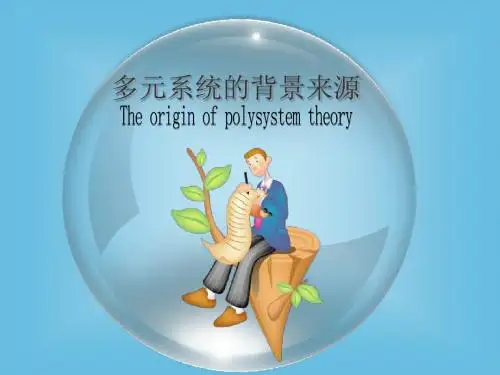
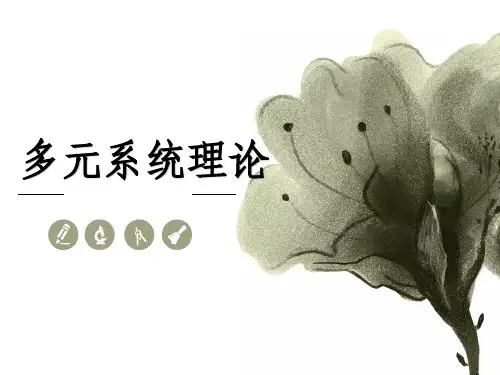

多元系统理论的起源多元系统理论于上世纪七十年代初由以色列学者Even-Zohar提出,然而其源头却可追溯到俄国形式主义时期。
形式主义对多元系统理论最大的贡献在于:形式主义提出了系统的概念,形式主义认为,系统是一种多层次的结构,其构成元素相互联系、相互作用(Baker, 2005: 176)。
形式主义者给文学研究带来革新,提出将文学作品看作是有次序、分等级的结构,而非由各不相干的元素组成的混合体。
他们看重的不是元素本身,而是各元素之间的相互关系。
“在形式主义概念中,文学革命的推动力是用陌生的取代熟悉的,用新鲜的取代传统的那股持续力量。
”在形式主义思想中,Yury Tynjanov 的思想与埃文-佐哈尔的多元系统理论关系最为密切。
Tynjanov是将文学视为“系统”的第一人。
他认为一个“文学事实”是一个相对的实体。
他声称“一个‘文学作品’、一种‘文体’、一个‘时期’、一种‘文学’、或者‘文学’本身,都代表了各种特征的总和,这些特征在与其它元素构成的网络中获得自身价值”。
他还提出了“中心/边缘对立”的概念,这一概念后被Even-Zohar采用。
多元系统理论的重要概念以Tynjanov和其他形式主义者的研究成果为起点,Even-Zohar在上世纪70年代初期开启了他自己的系统方法。
当时他的直接目标是解决与翻译理论以及希伯来文学的历史结构相关的问题。
他在这些领域对形式主义概念的运用最终导致了“多元系统理论”的诞生。
根据Even-Zohar的观点,“多元系统”指异质的、分等级的多个系统的聚合,各个系统相互作用,整个多元系统维持一种持续的、动态的发展状态。
在这种模式中,有三组对立:(1)“经典化的”产品或模式和“非经典化的”产品或模式的对立,类似于“高级”文学和“低级”文学的对立。
“经典化”的或“高级”的形式指“被一个文化的统治阶层视为合乎正统的文学规范和作品(即模式和文本),其最突出的产品被社会保存下来,成为历史遗产的一部分” (Even-Zohar, 1990b:15)“非经典化”的或“低级”的形式指“被那个阶层视为不合正统的规范和作品,其产品通常最终被社会遗忘(除非其地位有所改变)”。
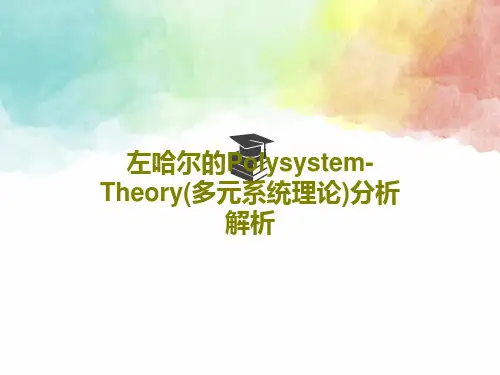
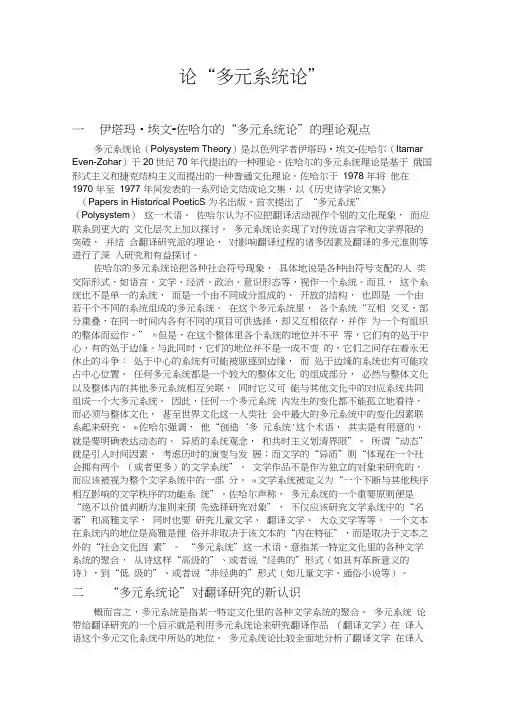
论“多元系统论”一伊塔玛•埃文-佐哈尔的“多元系统论”的理论观点多元系统论(Polysystem Theory)是以色列学者伊塔玛•埃文-佐哈尔(Itamar Even-Zohar)于20世纪70年代提出的一种理论。
佐哈尔的多元系统理论是基于俄国形式主义和捷克结构主义而提出的一种普通文化理论。
佐哈尔于1978 年将他在1970 年至1977 年间发表的一系列论文结成论文集,以《历史诗学论文集》(Papers in Historical PoeticS 为名出版,首次提出了“多元系统” (Polysystem)这一术语。
佐哈尔认为不应把翻译活动视作个别的文化现象,而应联系到更大的文化层次上加以探讨。
多元系统论实现了对传统语言学和文学界限的突破,并结合翻译研究派的理论,对影响翻译过程的诸多因素及翻译的多元准则等进行了深入研究和有益探讨。
佐哈尔的多元系统论把各种社会符号现象,具体地说是各种由符号支配的人类交际形式,如语言、文学、经济、政治、意识形态等,视作一个系统。
而且,这个系统也不是单一的系统,而是一个由不同成分组成的、开放的结构,也即是一个由若干个不同的系统组成的多元系统。
在这个多元系统里,各个系统“互相交叉,部分重叠,在同一时间内各有不同的项目可供选择,却又互相依存,并作为一个有组织的整体而运作。
” [1]但是,在这个整体里各个系统的地位并不平等,它们有的处于中心,有的处于边缘。
与此同时,它们的地位并不是一成不变的,它们之间存在着永无休止的斗争:处于中心的系统有可能被驱逐到边缘,而处于边缘的系统也有可能攻占中心位置。
任何多元系统都是一个较大的整体文化的组成部分,必然与整体文化以及整体内的其他多元系统相互关联,同时它又可能与其他文化中的对应系统共同组成一个大多元系统。
因此,任何一个多元系统内发生的变化都不能孤立地看待,而必须与整体文化,甚至世界文化这一人类社会中最大的多元系统中的变化因素联系起来研究。
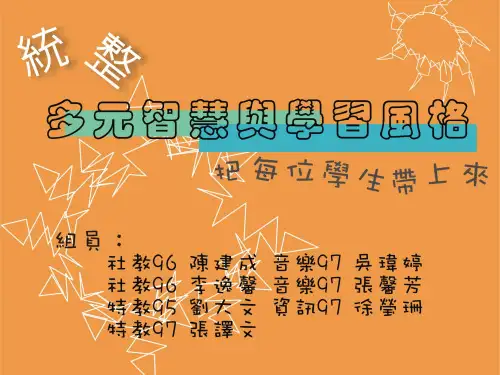

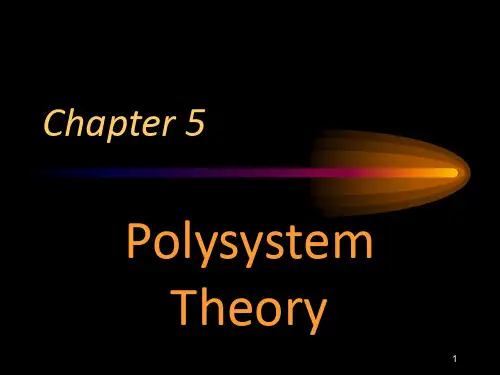
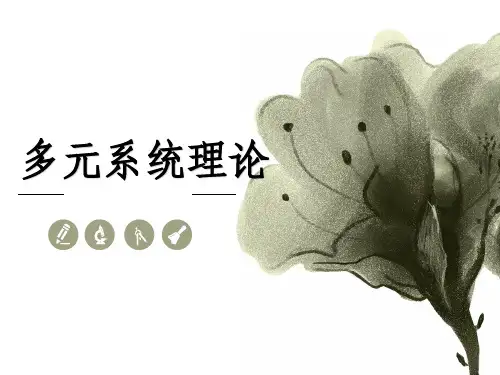
多元系统理论多元系统理论:翻译研究领域的拓展谢天振多元系统理论(Polysystem theory)是以色列学者埃文-佐哈尔早在二十世纪七十年代初就已经提出的一种理论。
1978年,埃文-佐哈尔把他在1970年至1977年间发表的一系列论文结成论文集,以《历史诗学论文集》(Papers in Historical Poetics)名出版,首次提出了“多元系统”(polysystem)这一术语,意指某一特定文化里的各种文学系统的聚合,从诗这样“高级的”、或者说“经典的”形式(如具有革新意义的诗),到“低级的”、或者说“非经典的”形式(如儿童文学、通俗小说等)。
埃文-佐哈尔的多元系统理论虽然在西方学术界早就引起了相当热烈的反响,但由于上世纪七十年代中国大陆特殊的国情,所以直至八十年代末国内学术界对它仍知之甚微。
直至九十年代初,随着我国改革开放政策的实施以及走出国门进行国际学术交流的学者越来越多,才开始有人接触到了多元系统理论。
但是真正把它介绍到国内学术界来,那也已经是九十年代末的事了。
比起国内学术界,我国香港台湾的学者与多元系统理论的接触显然要比大陆学者早,他们在1994年即已直接聆听了埃文-佐哈尔的报告,但是令人遗憾的是,埃氏的多元系统理论在台港也同样在很长一段时间内“没有引起很大的廻响”。
1在台港,埃氏的多元系统理论也要到上世纪九十年代末、本世纪初才真正引起人们的关注――2001年第3期《中外文学》推出的“多元系统研究专辑”也许可视作这方面的一个标志。
埃氏的多元系统理论之所以迟迟未能在华人文化圈内产生较为热烈的反响,一方面固然是因为埃氏的多元系统理论本身比较艰涩,牵涉的学科又过于庞杂,如语言、文学、经济、政治等,无不涉及;另一方面,更因为我国翻译界对翻译的研究和关注较多地仍旧停留在文本以内,而对翻译从文化层面上进行外部研究的意识尚未确立,这使得他们即使接触到了埃氏的多元系统理论,也一时会觉得它似乎与他们心目中的翻译研究相距甚远,甚至没有关系。